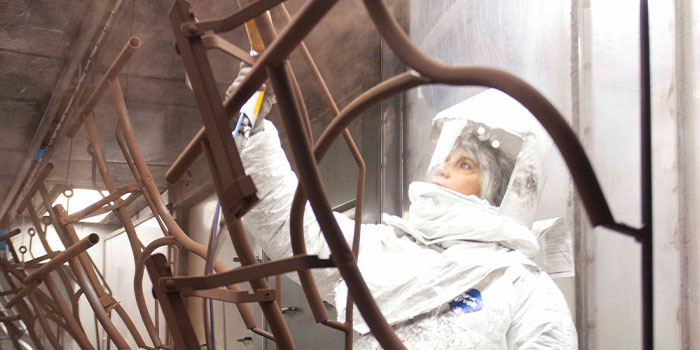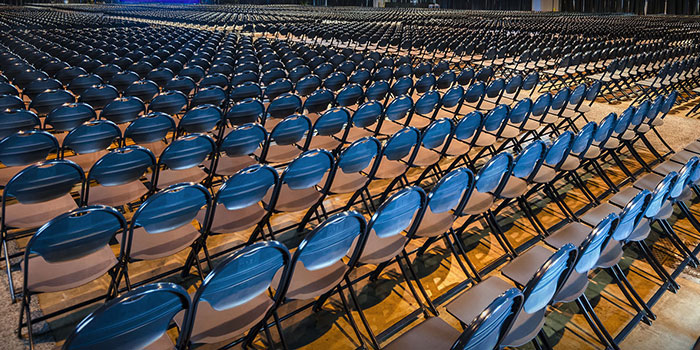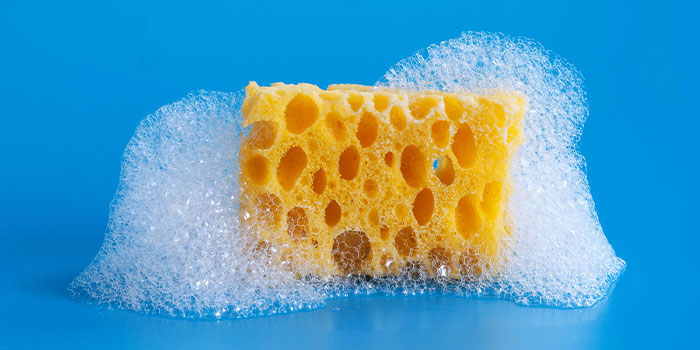
Commercial furniture requires regular maintenance, cleaning, and disinfecting to keep products looking nice, prevent stains from setting into upholstery, and prolong the life of the furniture.
This blog will walk you through the best ways to clean and disinfect the various types of MityLite products.
We have also included a link to some cleaning and disinfecting recommendations from the CDC.
Cleaning ABS Tables
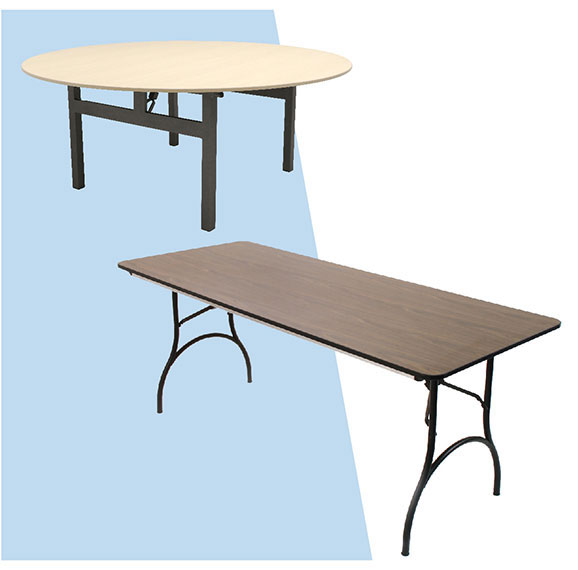
ABS Tables are designed to be easy to clean and disinfect surfaces. When possible, remove stains immediately.
To clean, use warm, soapy water and allow it to sit on the table to loosen dirt. Gently scrub with a nylon brush to help remove the dirt from the textured surface. Disinfect and remove tougher stains by using “409” or “Fantastic” cleaner. Use WD40 followed by soapy water to really disinfect the tabletop and remove more difficult stains.
If you prefer a chemical-free cleaning solution, a melamine sponge, such as Xtreme Sponge, may work well to remove dirt and stain
Avoid using citrus cleaners, such as Goo-gone, PIG, etc., bleach, paint thinner, concentrated detergents, acetone, MEK, and other strong solvents. These products take the plasticizers out of the plastic and might shorten the life of your table. Using such products might also void your warranty.
Cleaning Reveal & Madera PRO Tables
To clean the laminate surfaces of MityLite Reveal and Madera Linenless Tables, use dishwashing liquid, warm water, and a clean microfiber cloth. After the initial cleaning, use an approved EPA chemical disinfectant such as Clorox Healthcare Cleaner and Benefect. If the product contains bleach, it may cause some damage if it is not rinsed off the surface completely.
View the complete Cleaning and Care instructions to avoid damaging the table surface.
Cleaning Metal & Plastic Folding Chairs
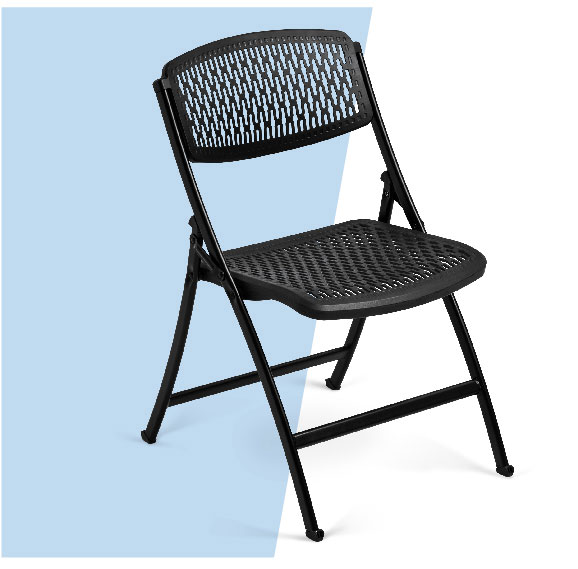
All MityLite folding chairs have a powder-coated steel frame that is easy to clean and disinfect. Using a soft wet rag with mild soap and water will clean up to 99% of all grime. However, be careful to avoid soaking the frame and squeeze water into the openings of the frame around the seat, backrest, and link rivets, etc.
To clean MeshOne® upholstery, use a mild household detergent or soap and water. However, avoid using petroleum distillates. To disinfect, particularly in healthcare environments, use a 10% dilution of bleach (90% water) to sterilize the mesh seat and backrest. However, avoid overexposing the fabric repeatedly throughout the day or allowing the mesh to soak in the bleach solution as it could adversely affect the mesh.
To clean the FlexOne® seat and back use a mild household detergent or soap and water. To disinfect, particularly in healthcare environments, use a 10% dilution of bleach (90% water) to sterilize the seat and backrest.
Clean and disinfect MityLite DuraMax PRO folding chairs with warm water and a regular dishwashing detergent such as Palmolive or Dawn. Apply the solution to a soft, micro-fiber cloth to wipe the resin furniture in a circular motion. Rinse it with clean and plain water. Avoid abrasive cleaners and sponges, including scouring sponges and metal brushes, as these can scratch the surface.
Remove scuff marks from white DuraMax chairs with Mr. Clean Eraser Pads.
Cleaning Banquet Chair Frames
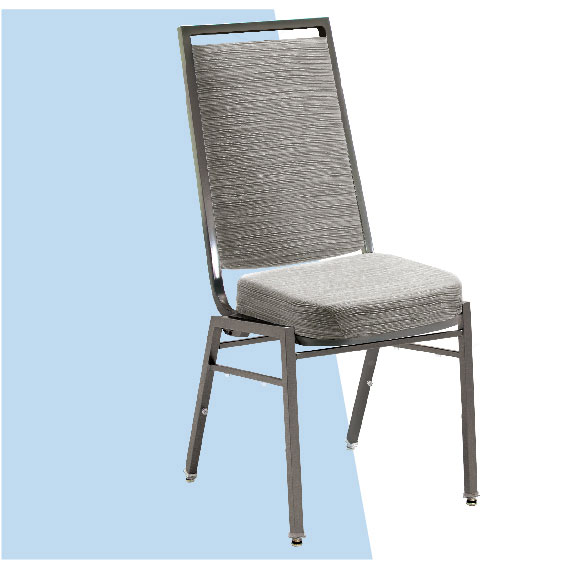
Steel Chair Frames
Several MityLite banquet chairs are manufactured with powder-coated steel frames that are easy to clean and disinfect. To clean, periodically wipe down the frames with a light solution of soap and water or non-caustic cleaning agents to remove surface dirt and perspiration residue. Use a standard cleaner to disinfect but avoid ones that are abrasive as that can erode some powder-coated finishes.
Aluminum Chair Frames
Other MityLite banquet chairs are manufactured with powder-coated aluminum frames that are also easy to clean and disinfect. Washing an aluminum frame is similar to washing a steel frame.
Clean aluminum frames with a sponge or soft bristle brush and a solution of mild soap and water. Rinse with water and let dry. Use a standard cleaner to disinfect but avoid ones that are abrasive as that can erode some powder-coated finishes.
You can restore the luster of glossy finishes by using lemon oil or high-grade automotive paste wax. However, avoid using these treatments on textured finishes such as faux wood. Soft Scrub® can also be used to remove scuff marks and scratches.
Cleaning Wood & Faux Wood Chair Frames
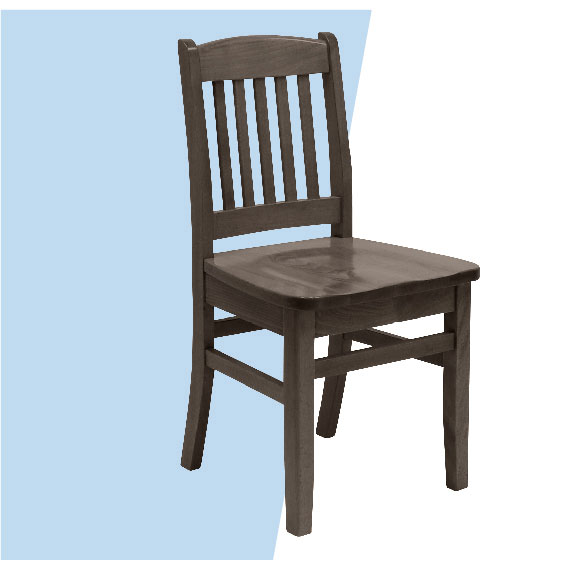
Wooden Chair Frames
Holsag is known for its lovely European Beech hardwood chair frames. All wood furniture should be cleaned and wiped down regularly to maintain the luster. It’s important to take extra precautions with wooden furniture since harsh cleaners may ruin the finish.
Also regularly dust wooden chair frames. Choose a soft duster that will not scratch the surface.
When cleaning and disinfecting, always use a soft, non-abrasive cloth. We recommend using a cleaner called Virox, a hydrogen peroxide-based disinfectant that is less harmful to the user, the chair frame, and the environment. Bleach can be used provided it is properly diluted and applied.
For standard cleaning, you can use a mild solution of soap and water applied with a damp rag. Dry the wood immediately as leaving water on the wood for an extended period might damage the finish.
You can also purchase other cleaners that are specially formulated for wood, however; make sure you read the labels carefully to see if it’s an appropriate cleaner to use on a lacquer finish, which is what is used on Holsag wooden chairs. Avoid abrasive cleaners and may void the frame warranty.
In our opinion, the finish is the key to the lasting appearance of wooden chairs. If the chairs don’t have a strong lacquer finish, like the one used on Holsag chairs, the wood can become damaged and faded over time. In addition, unprotected wood can absorb grime, spills, and germs. Always ask about the finish before purchasing wooden chairs.
Faux Wood Chair Frames
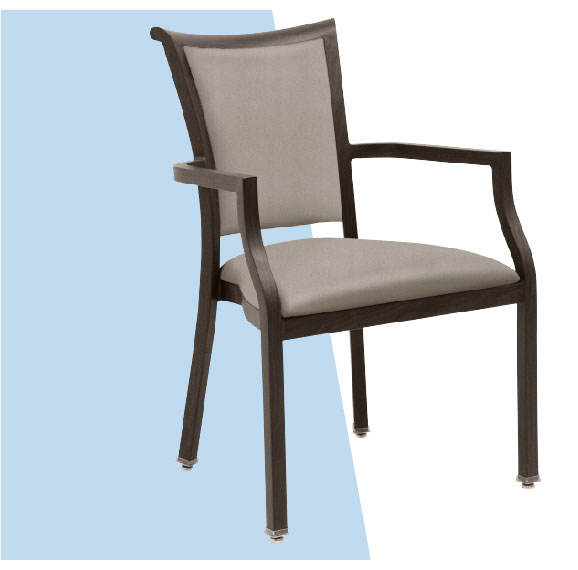
Some Holsag chairs are made with a faux wood frame. Faux wood chair frames are manufactured with aluminum that is powder-coated and then a grain transfer paper is applied to the frame to produce the look of a finished wood grain. It’s best to wash these frames with a sponge or soft bristle brush and a solution of mild soap and water. Rinse with water and let dry. You can also use Soft Scrub® to remove scuff marks and scratches.
To disinfect, use a standard cleaner but avoid ones that are abrasive as that can erode some powder-coated finishes.
Although lemon oil and automotive paste wax can be used on some aluminum frames, avoid using these with faux wood because it can disrupt the texture of the finish.
Cleaning Upholstery
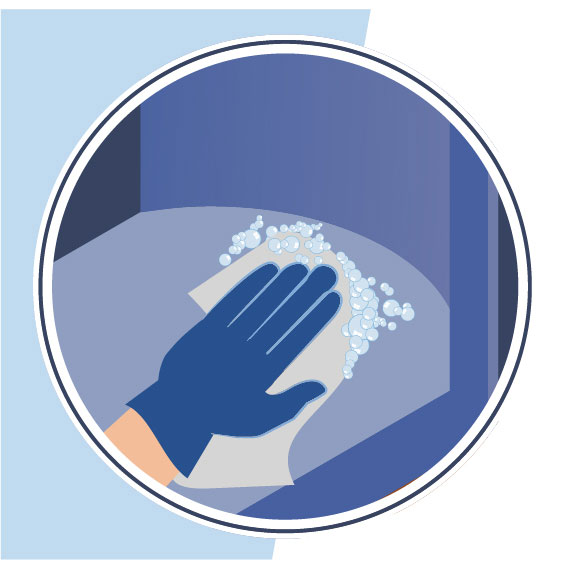
Vinyl & Polyurethane
If your chairs have a vinyl cushion, use a gentle mixture of any mild soap and warm water to dissipate the most common soil from the surface. Wash the cushion using a soft cloth. If stubborn dirt remains, such as a stain embedded in the grain, use a soft brush.
To disinfect, use a touch of cleaning powder or bleach and clean water. We recommend using a solution of bleach and clean water. Use one teaspoon of bleach for every one gallon of water. Make sure to measure carefully as stronger concentrations can damage the material. Apply the solution with a damp rag.
Always rinse and dry the cushion’s fabric with a soft cloth.
Fabric Upholstery
Doing regular light cleaning of fabric upholstery is important, but you need to be careful not to use cleaning techniques that might cause the fabric to fade.
Light Fabric Cleaning
Day-to-day cleaning and light maintenance will pick up dust and airborne debris. The best items to use for these tasks are lint rollers and vacuums.
Lint Rollers
Lint rollers are great for quick cleaning after events and meetings. They can pick up hairs, dirt, and other fibers. The advantage of using a lint roller, as compared to most fabric brushes, is that the sticky paper lifts the fabric, rather than flattening it and rubbing dirt into the weaves of the fabric. Pushing dirt into the fabric fibers is eventually what dulls the color and leaves the furniture looking worn.
Vacuum
Though it is not necessary to vacuum every day, doing a light run every week, using nozzle attachments, will help reduce built-up grime.
Fabric Washing
A light lather can reverse regular wear and uplift small, set-in debris from woven fabric.
Chairs upholstered with fabric and treated with a performance treatment—such as Nanotex, InCase, Crypton, iClean, or Alta—will generally clean nicely. In fact, you may notice a brighter color and a better general aesthetic to the fabric after cleaning.
However, a fabric made using cotton, polyester, nylon, and wool (or a mixture of these yarns) that is not treated with a performance treatment will be more difficult to clean, especially if the material is stained. It also may not brighten after general cleaning.
Something else to note, Scotchguard and Teflon are not performance treatments. These formulas are sprayed onto a material versus an actual performance treatment, such as those mentioned above, which encapsulate the yarn in a process where the material is immersed in a liquid bath. This is why it’s important to have chair fabric treated at the time of purchase.
To disinfect fabric made with 100% polyolefin material, use a bleach solution to sanitize the material without bleaching out the color.

Precautions When Cleaning
Although cleaning chairs regularly is important, use as little liquid as possible. This will help keep your fabric looking better for longer. Using too much water can leave visible watermarks or soak the upholstery and the foam padding underneath it, causing the fabric to lose its integrity (it can shrink or sag).
Also, avoid water contact with the metal parts of the chair, particularly any zippers around the seat cushions, as they can rust if not dried thoroughly.
Before washing any upholstery, find out the Cleanability Code for the fabric, which tells you how to clean the fabric without damaging it. You can find this code by finding the fabric in our fabric center and checking the Cleanability Code, or by referring to a fabric card sample sent to you by your MityLite Sales Rep. Some fabrics will be damaged by water. If your label says, “dry clean only” then it will need to be professionally cleaned.
To ensure your chairs and furniture are water-safe, test a small inconspicuous area and wait a few hours to see if the water affects the fabric.
How to Create a Disinfecting Solution
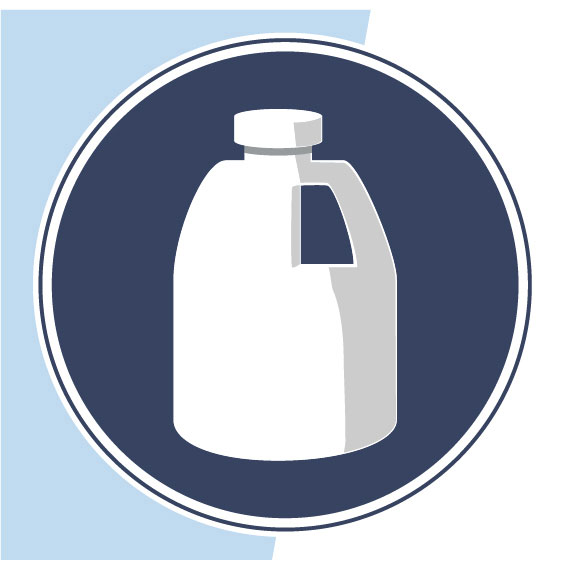
Make a cleaning solution by mixing ¼ cup dishwashing liquid with 1 cup of warm water. With an electric hand mixer, whisk the solution until a dense layer of thick, dry suds forms across the top.
Use a clean cloth to gently massage the suds into the fabric, being careful not to rub, as rubbing will work the dirt and germs deeper into the woven fabric fibers. Pressing hard, use a rubber cooking spatula to scrape away the dirty suds. Rinse, by dabbing the washed area with a warm, damp cloth.
Always allow the fabric or furniture to thoroughly dry before use, as moisture will cause more dirt to cling to the chair’s surface.
Deep Cleaning and Removing Set-In Stains
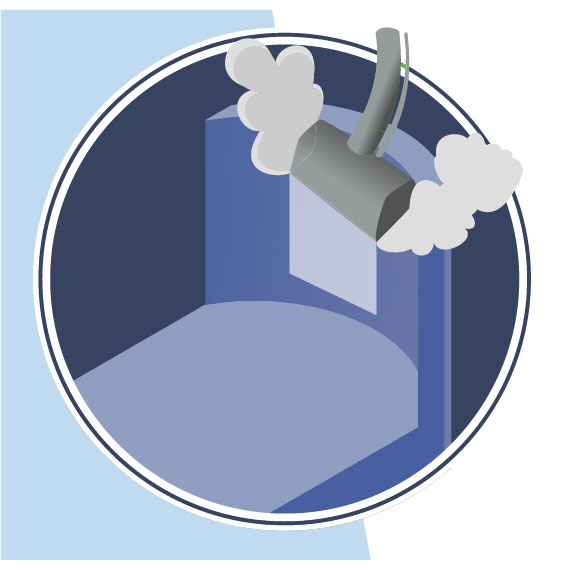
Stains, immediate or set in, are always tricky to remove from chair upholstery. There’s a chance the simple soap and water method shown above could do the trick. However, sometimes the fabric needs heavier cleaning to remove stains.
Here are some measures you can take.
Steam Cleaning
Steam, unlike straight water, has moisturizing properties that will hydrate a stain without saturating it completely with liquid. Once a stain is moisturized, it may loosen from the fibers and become easier to blot out. Using a steam vacuum is the easiest way to do this. However, putting a standard iron with a steam setting over the spot may do the trick as well.
Vinegar
Vinegar has natural solvent properties that may help loosen and lift set-in stains. Apply vinegar to upholstery with a damp, clean rag and blot over the desired area. Then, take a second towel to soak up any remaining fluid and grime.
Though vinegar has an odor, the smell will evaporate after the chair is completely dry.
Cleansers*
If the above methods don’t work, try a commercial-grade fabric cleansing spray. These products contain solvents that chemically attack set-in stains.
Some of our favorites are:
- Resolve Stain Remover
- Tuff Stuff Multi-Purpose Foam Cleanser
- Folex Stain Remover
- BISSELL Spot & Stain Fabric and Upholstery Cleaner

*Please use caution with commercial-grade solvents. Most use powerful chemicals that may ultimately damage your fabric. Before using throughout the chair, always check the upholstery label and test it in a small area.
Also, never rub in the solution as rubbing can deepen the stain and fray the fabric fibers causing more damage to your furniture.
Stain & Spot Removal for Upholstered Chairs
| Type of Stain | What To Do |
|---|---|
| Wine, other alcoholic beverages, and soft drinks | Use only water-based cleaning agents or foam. Mix 2 tablespoons ammonia or ammoniated detergent, such as Ajax™ liquid, to a quart of water. Wipe the stain gently with a cloth dampened with the solution. Continue turning the cloth so you’re always using a clean portion. |
| Chocolate and coffee | Remove with a sponge and lukewarm water |
| Deodorants or Grease | Use only mild, pure, water-free, dry-cleaning solvents, such as Energine™ or Carbona™. Wet a cloth with the cleaning solution. Wipe the stain gently and continue turning the cloth so you’re always using a clean portion. |
| Fruit and berry stains | Treat with cold water |
| Pencil lead or rubber cement | Use only mild, pure, water-free, dry-cleaning solvents, such as Energine or Carbona. Wet a cloth with the cleaning solution. Wipe the stain gently and continue turning the cloth so you’re always using a clean portion. Follow with a small amount of ammoniated liquid detergent and rinse thoroughly. |
| Urine, mucilage, and perspiration | Use only water-based cleaning agents or foam. Mix 2 tablespoons ammonia or ammoniated detergent, such as Ajax liquid, to a quart of water. Wipe the stain gently with a cloth dampened with the solution. Continue, turning the cloth so you’re always using a clean portion. Follow with a small amount of ammoniated liquid detergent and rinse thoroughly. |
| Vomit | Treat with cold water. Follow with unseasoned meat tenderizer. Let sit for 10-15 minutes. Rinse, let dry, vacuum. |
| Mud | Lift away whatever can be removed easily with a dull knife. Let dry, then vacuum. If the stain persists, clean with a cloth dampened with an ammonia water solution. Mix 2 tablespoons ammonia or ammoniated detergent, such as Ajax liquid, to a quart of water. Wipe the stain gently with a cloth dampened with the solution. Continue turning the cloth so you’re always using a clean portion. |
| Pencil lead or rubber cement | Use only mild, pure, water-free, dry-cleaning solvents, such as Energine or Carbona. Wet a cloth with the cleaning solution. Wipe the stain gently and continue turning the cloth so you’re always using a clean portion. Follow with a small amount of ammoniated liquid detergent and rinse thoroughly. |
| Candle wax | Remove surface wax with dull knife or cover the spot with several paper towels and apply a warm iron. Use only mild, pure water-free dry-cleaning solvents, such as Energine or Carbona. Wet a cloth with the spot cleaner and wipe the stain gently. Continue turning the cloth so you’re always using a clean portion. |
| Chewing Gum | Remove surface gum with a dull knife. Use only mild, pure, water-free, dry-cleaning solvents, such as Energine or Carbona. Wet a cloth with the spot cleaner and wipe the stain gently. Continue turning the cloth so you’re always using a clean portion |
| Ink or ballpoint pen | Use rubbing alcohol. Use only water-based cleaning agents or foam. Mix 2 tablespoons ammonia or ammoniated detergent, such as Ajax™ liquid, to a quart of water. Wipe the stain gently with a cloth dampened with this solution. Continue turning the cloth so you’re always using a clean portion. |
One Final Note
Remember to store your chairs in an environment that is safe and free of grime. This will increase the amount of time needed between cleanings.
For more guidelines about cleaning and disinfecting products, visit cdc.gov.
